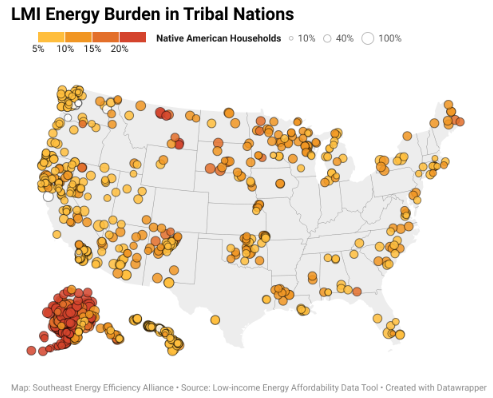December Map of the Month

By Laura Diaz-Villaquiran
Source: U.S. Census Bureau - American Indian, Alaska Native, and Native Hawaiian Areas (AIANNHAs). U.S. Department of Energy – Low-Income Energy Affordability Data Tool (LEAD).
Native American communities in the United States face steep barriers to accessing energy efficiency and clean energy resources, while experiencing disparities in access and reliability of electric service. According to a 2023 report from the U.S. Department of Energy, tribal communities experience higher than average energy costs and burdens, while also having a higher number of unelectrified homes and a greater frequency of power outages.
December’s map of the month uses data from the U.S. Department of Energy’s Low-Income Energy Affordability Data (LEAD) tool to highlight the energy burdens faced by low- and moderate income (LMI) American Indian, Alaska Native, and Native Hawaiian households. The geographies in this map come from the U.S. Census Bureau and include federally recognized tribal lands, state-recognized reservations, off-reservation trust lands, tribal subdivisions, Alaska Native Regional Corporations, and Native Hawaiian home lands.
Energy burden is a measure used to assess a household’s ability to afford their energy costs and is calculated by dividing a household’s annual energy expenses by their income. Nationally, Native American households face median energy burdens that are 45% higher than that of white (non-Hispanic) counterparts.
We find that 86% of low- and moderate-income Native American households have high energy burdens, meaning that they pay at least 6% of their income for their energy bills. Out of those households, 50% have energy burdens that are considered severe, which require spending at least 10% of income to cover energy expenses.
The highest tribal energy burdens are concentrated in Alaska. This is driven by Alaska’s high per capita energy consumption, reliance on diesel-fueled electric generators, and sub-Arctic temperatures. Many rural communities in Alaska are not connected to the Railbelt energy grid and have high-cost utilities resulting from this lack of interconnectivity and the expense of delivered fuels.
Tribal communities' experiences of energy insecurity are shaped by legacies of colonization, forced displacement, marginalization and federal policies that have contributed to the disparities that exist today.
Despite energy affordability challenges, Native communities have been at the forefront of the environmental and energy justice movements and are leading the way in shaping a clean energy future, and DOE’s 2023 report notes that federal investments are “having a tangible impact” on improving energy access and reliability.
The U.S. Department of Energy’s Office of Indian Energy Policy and Programs contains a Tribal Energy Projects Database where you can learn more about 221 tribal-led energy projects across the country, with 151 of those focusing on workforce development, weatherization, photovoltaic energy generation, energy efficiency, and the deployment of renewable energy technologies.
Federally funded projects support indigenous communities' energy sovereignty and climate resilience. Solar installations, for example, help reduce the need for transported fuels to remote locations and protect the residents of tribal lands from rolling utility blackouts.
Additionally, the U.S. Environmental Protection Agency (EPA) recently deployed unprecedented funding to support clean energy and energy efficiency projects in tribal communities through the Community Change Grant initiative. In the most recent award period, 9 projects in Alaska received upwards of $180 million in funding to support equitable climate solutions. Some of those awardees are:
- The Kotzebue Tribal Wind project, which will build two tribally owned 1MG wind turbines;
- The Huslia Village Climate Solutions project, which will provide critical water and sewer infrastructure to the Koyukuk-hotana Athabascan village. The funding for this project will be directed towards weatherizing “16 homes to reduce energy costs,” build 8 new energy efficient homes, and install grid-connected rooftop solar systems in this rural community;
- The Chenega Bulk Fuel Storage System and Renewable Integration Project, which aims to decrease Chenega’s reliance on diesel fuel through the installation of solar arrays with battery storage.

